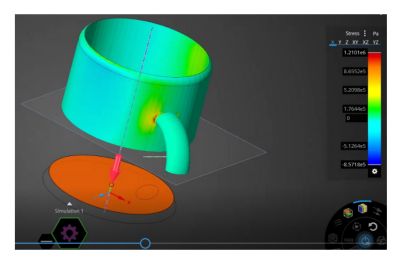-
-
Kostenlose Software für Studierende
Ansys unterstützt die nächste Generation von Ingenieur*innen
Studenten erhalten kostenlosen Zugang zu erstklassiger Simulationssoftware.
-
Verbinden Sie sich jetzt mit Ansys!
Gestalten Sie Ihre Zukunft
Stellen Sie eine Verbindung mit Ansys her, um zu erfahren, wie Simulation Ihren nächsten Durchbruch vorantreiben kann.
Länder und Regionen
Kostenlose Demoversionen
Produkte & Dienstleistungen
Lernportal
Über das Unternehmen
Back
Produkte & Dienstleistungen
Back
Lernportal
Ansys unterstützt die nächste Generation von Ingenieur*innen
Studenten erhalten kostenlosen Zugang zu erstklassiger Simulationssoftware.
Back
Über das Unternehmen
Gestalten Sie Ihre Zukunft
Stellen Sie eine Verbindung mit Ansys her, um zu erfahren, wie Simulation Ihren nächsten Durchbruch vorantreiben kann.
Kostenlose Demoversionen
ANSYS BLOG
February 20, 2023
Empowering Tomorrow’s Engineers: Ansys Academic Program Adds More Simulation Tools to Free Student Downloads
Millions of students around the world benefit from Ansys’ free student software, which recently surpassed 2.6 million downloads. Now with Ansys’ latest product release, students have even more simulation tools to explore.
Free student software has been a key component of the successful Ansys Academic Program since 2015. The program provides universities with deeply discounted software for use in the classroom or in research while supplying students with free resources for self-learning. Currently, the program reaches more than 3,300 universities across 92 countries.
Student product bundles have always provided a generous range of multiphysics simulation, including mechanical, fluids, electromagnetic, and thermal analyses. Today, Ansys’ free student products offer more engineering disciplines and benefits with newly added optical design software and easier access to 3D design tools.
What’s New for Students in Ansys 2023 R1?
With the recent release, Ansys Discovery Student is now part of Ansys Student. Previously, Discovery was a standalone product that required a separate download. Now, students who download the Ansys Student package will have direct access to Discovery 3D simulation software. They will also have access to Ansys Speos optical design and validation software, which was also added to the product bundle.
With both additions, Ansys Student provides an even wider set of solutions to tackle engineering projects in innovative ways. Discovery features the first simulation-driven design tool that combines instant physics simulation, high-fidelity simulation, and interactive geometry modeling within one easy-to-use experience. For this reason, educators at the University of Michigan use Discovery to introduce simulation to first-year engineering students without the typical learning curve of conventional simulation tools. In one project, students designed a coffee mug and learned how to change its dimensions and materials to manipulate stress and temperature effects throughout the mug.

Students at the University of Michigan simulate a coffee mug in Ansys Discovery to determine stress and temperature effects in its handle.
Looking beyond 3D design, students can use Speos to enhance optical designs and achieve high-fidelity visualization based on human vision capabilities. Speos combines powerful light analysis with illumination evaluation across the electromagnetic spectrum. For example, students at the University of Toronto implemented Speos to design and optimize a solar-powered racecar to meet competition regulations that required permanently-on headlights — a feature that typically consumes up to 82% of power from the car’s electrical system. However, Speos enabled the team to design an optical reflector shape that drew the least amount of power and met regulations.

Speos irradiance simulation of the daylight running light (DRL) module. An optimized reflector designed with Speos focuses the beam into the regulated zone and reduces wasted light spill (left). Without a custom-designed reflector, a great deal of the light is wasted by spilling out of the regulation zone (right).
Take Five: Free Student Incentives, Courtesy of Ansys
Students can download any or all of the five free student product bundles that are each packed with popular simulation tools.
Here is an overview of what’s included in each bundle:
|
Ansys Electronics Desktop Student
|
|
|
|
In addition, students can explore more than 280 free Ansys Innovation Courses in engineering areas ranging from structures and fluids to photonics and more. They can use the courses as a complementary tool to complete homework assignments and practice course material for hands-on learning. Students can also engage with peers through the Ansys Learning Forum for further discussion about course topics.

Students can download up to five free student software packages and explore more than 280 free Ansys Innovation Courses.
University Support and More
Universities benefit from the Ansys Academic Program, too. Ansys provides academic institutions with deeply discounted software for use in the classroom or in research, access to Ansys Innovation Space, and free research software for university-based student teams in competition.
University product bundles are tailored for several usage tiers, including teaching, research, and associate. Products in these bundles are our full commercial products without limits, while student products have limits such as the size of the simulation that can be performed. Teaching and student offerings are designed to complement one another so that, ideally, educators can teach using our full software versions on campus, while students can study and practice using free software at home.
For additional teaching aids, the Ansys Educator Hub provides a repository of resources categorized by engineering discipline for convenience, and Ansys Education Resources offers case studies, practice exercises, teaching packages, and more. Educators can also take advantage of Ansys’ Academic Webinar Series, which highlights how simulation can strengthen engineering curricula.

The Ansys Academic Program provides academic institutions with deeply discounted software for use in the classroom or in research, as well as additional resources, teaching aids, and incentives.
As an advocate of simulation integration within academia, Ansys collaborates with universities to develop courses and programs. Cornell’s popular edX course “A Hands-on Introduction to Engineering Simulations” describes how to analyze real-world engineering problems using Ansys simulation software and gain important professional skills. In another collaboration, Ansys worked with the Technical University of Madrid (UPM) to create an online master’s degree in numerical simulation using Ansys software. The degree program has modular content that includes nonlinearities, implicit and explicit dynamics, aerodynamics, and more.
To encourage more members of academia to consider simulation integration, Ansys invites educators of accredited academic institutions to submit proposals to create innovative undergraduate engineering curricula or evolve existing courses to incorporate Ansys simulation. Selected projects will receive a grant and relevant technical guidance for creating or evolving an existing course or set of courses that combine Ansys technologies with proven teaching and assessment methods, such as active learning techniques and project-based learning. For more information and proposal submission dates visit Ansys Funded Curriculum.
By providing simulation-integration opportunities to all members of academia, the Ansys Academic Program upholds Ansys’ dedication to equip tomorrow’s engineers with the tools they need today. The latest free student software release is another demonstration of this longstanding commitment.
For more information, visit Ansys Academic.